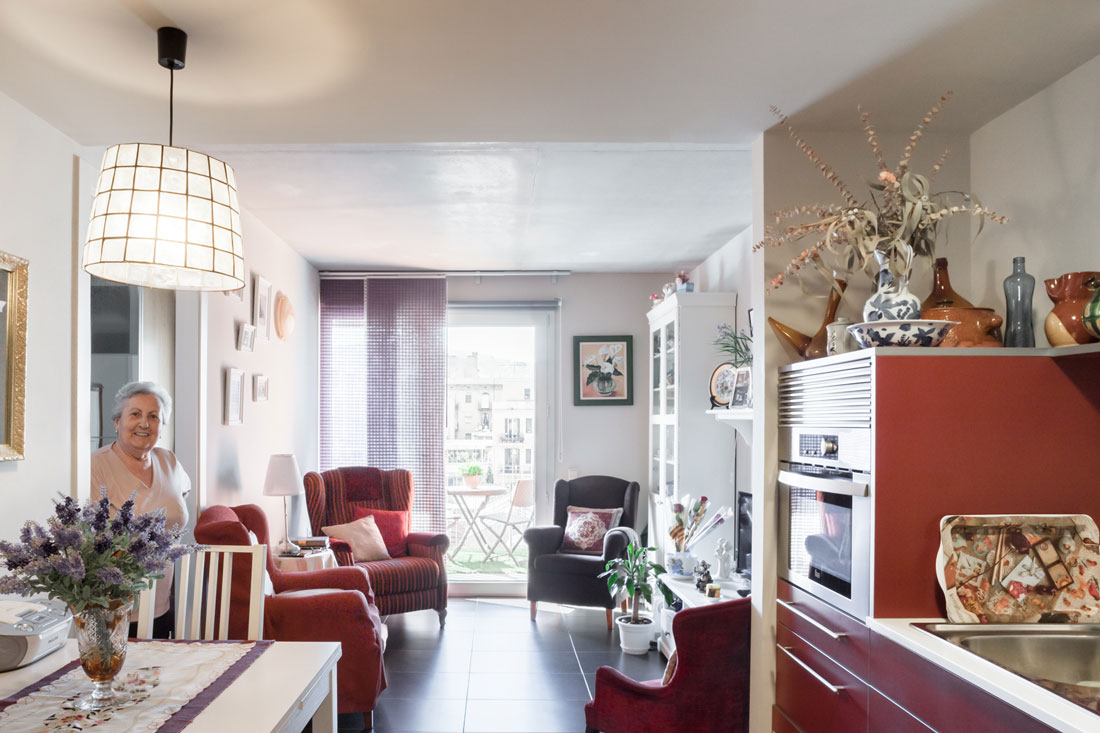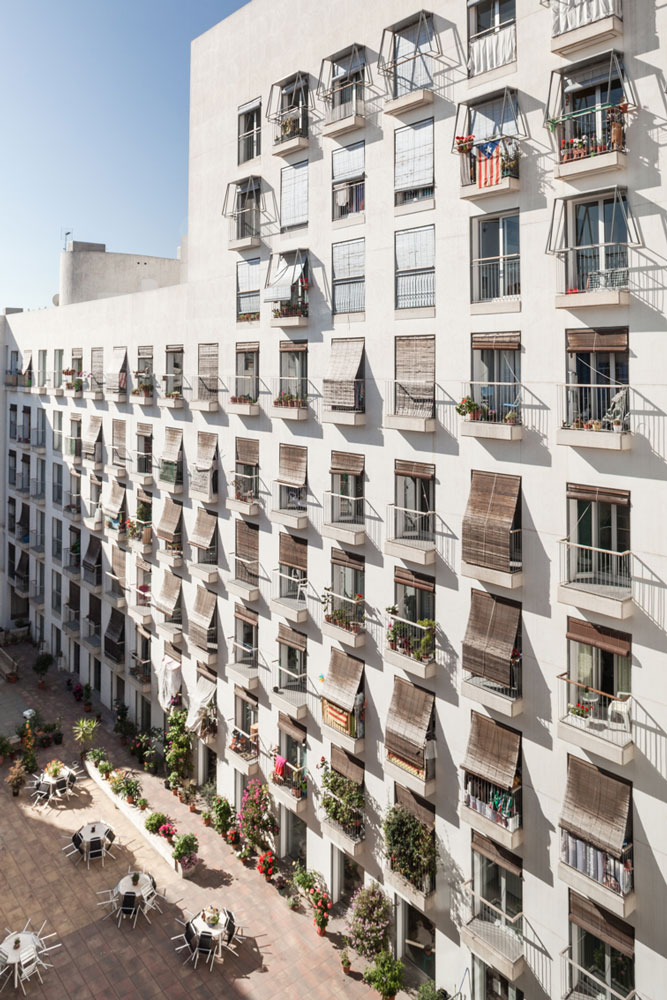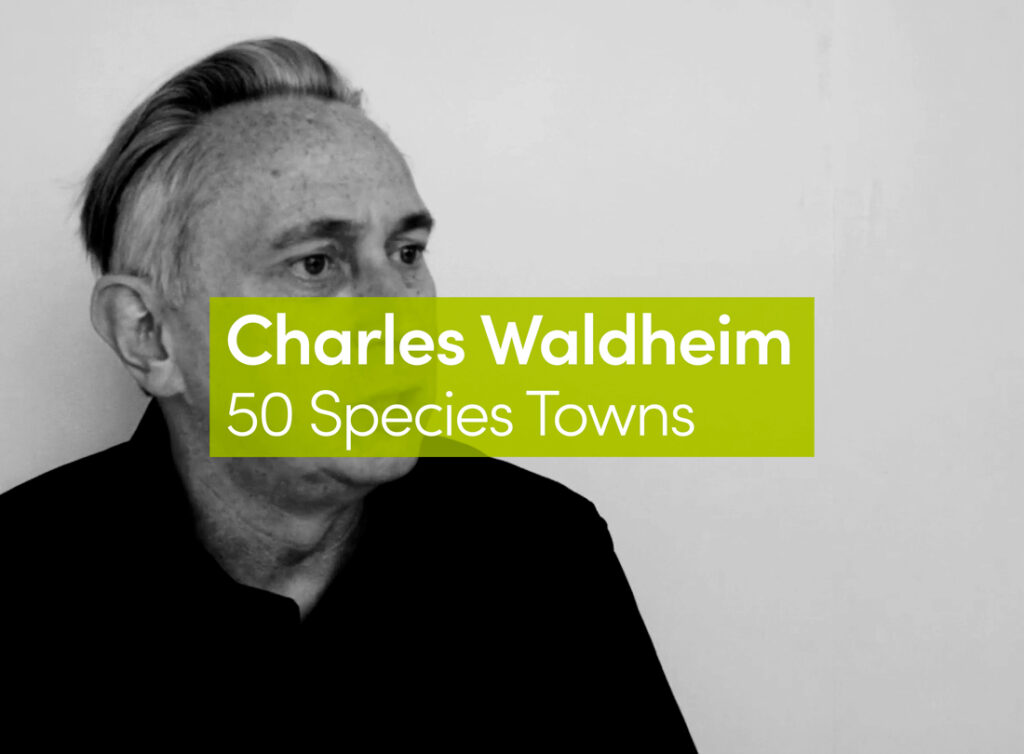The increase in life expectancy in Western countries is bringing about significant changes in the social structure of major European cities.
In recent years the city of Barcelona has similarly experienced a change in the age structure of its residents: the trend being a general aging of the population due to a decrease in the younger generations (under 16 years of age) combined with the constant growth of the older generations (over 65 years of age). It is important to note that more than half of the latter are women and, when looking at octogenarians, the ratio is two out of three. Therefore, over the past few years the Catalan capital has seen a rise in single-member households, consisting mainly of elderly widowed women.
To address the housing emergency, the municipality of Barcelona has developed, through the Patronat Municipal de l’Habitatge de Barcelona (PMHB), an interesting project of diversifying the housing market by offering homes designed specifically for the needs of the elderly called viviendas dotacionales.
These social housing units, which are regulated by the law 18/2007 concerning housing rights, are similar to those that are provided support and assistance by the local social services in Barcelona.
The vivienda dotacional model offers the elderly a social accommodation which is comfortable, adapted to their needs and is integrated in the local community. Moreover, such households have both direct assistance thanks to the personnel of the center, and indirect assistance through a helpline service, in order to maintain a high degree of personal autonomy for as long as possible.
In order to reinforce the offer of public housing and as a way to counter a shortage of building plots for social housing purposes, the municipality of Barcelona allows the construction of these structures in areas intended for services. As a result, a “hybrid” model of social housing has been created, where district service centers are combined with 40 sq.meter accommodations and other communal spaces providing amenities that can be shared by the inhabitants of the same building complex. These buildings include communal spaces designed to be a natural extension of private housing spaces, capable of providing a balanced mix of services and activities, which are vital to residents reaching their full potential.
According to the World Health Organization (WHO), a person’s health, in combination with assistance services and appropriate housing, represent the essential conditions for active aging.
Every unit features a high versatility of the spaces and a simple pattern of distribution: an interior space which links the kitchen to the living room and the entrance, creating an open common area, and a separate sleeping area containing a double room and a fully accessible bathroom.
All apartments (Figure 1) are barrier-free and feature all the necessary comforts, allowing the elderly to live autonomously and in total safety: curbless showers, anti-slip flooring, electrical sockets accessible at a minimum height of 50cm from the floor, potable solar-powered water heating, heating, emergency lighting and alarm systems directly connected to the concierge service. In communal areas the residents can access a range of public amenities which are generally provided in the housing units: common rooms, laundries, permanent assistance service areas, libraries, cafeterias, medical practices and fitness areas. These facilities guarantee social integration amongst residents in the housing complex and help facilitate their daily life activities. All services provided by viviendas dotacionales are managed directly by the social services of the municipality which handle the cleaning and maintenance of the housing units, as well as the coordination of leisure activities.
Figure 1: Cibeles – Photo by Stefano Ferrando
The homes for the elderly are located both in historical districts and newly expanding areas of the city. To date, 1700 accommodations for the elderly have been created in the 10 city districts, and these services are expected to be present in those districts where they are missing or lacking.
Located in the heart of the historic center of Barcelona, the residential building on carrer Colomines (Figure 2), together with the recovery of the old market of Santa Caterina, is part of the urban regeneration of the entire Avinguda Cambó area. The 59 housing units for the elderly create a curved space, and the difference in height produced by the waved roofing of the market in front creates a fluid public space.
Figure 2: Santa Caterina – Photo by Stefano Ferrando
These small public spaces featuring a strong urban feeling enrich the entrances to the market yet correspond well to the historical residences, creating small squares which then lead to the residential complex entrance. This creates the sensation of an urban market which is full of life and daily activities. The centrality of the building guarantees the proximity to public services, green areas, transportation and those activities which allow the elderly to live their lives independently, by granting access to all the necessary services within a range of 500 meters.
A residential complex of 127 apartments with social tenancies (Figure 3) is located in the district of El Raval, one of the oldest in town, with 97 housing units for the elderly. The building has a huge social significance for the whole area, as the ground floor hosts a senior day center and a civic center which encourage social cohesion in a multiethnic district which is lacking in aggregation areas.
Figure 3: Reina Amalia – Photo by Stefano Ferrando
The architecture of the building has a vital role in uniting the district of El Raval and the bordering district of Sant Antoni. The large openings on the main façade create an architectural scenery that overlooks the square.
In 2011, on the northern outskirts of Barcelona a residential complex (Figure 4) was built within one of the access points of the urban park of Nou Barris, in order to grant the residents direct contact with nature both physically and visually.
Figure 4: Urrutia – Photo by Stefano Ferrando
The building, consisting of 50 apartments, community rooms, a laundry and a youth recreation area on the ground floor, is divided into three blocks and takes full advantage of the uniqueness of the area: all accommodations have the best views of the park.
The circulating passages are well placed within the irregular layout of the building by expanding to create common areas and balconies on the northern and southern façades. Consequently, the circulation area also becomes a social element which, along with the community spaces, reduces the feeling of segregated individual households.
In close proximity to the carrer Urrutia building, there are the households in Can Travi which consist of 85 apartments with social tenancies, community spaces, a civic center for the district, a leisure room and a library. The residential complex of Can Travi is located in the district of Horta-Guinardó, a neighborhood of the city which is undergoing a significant redevelopment process.
The project cleverly makes use of its surroundings. The spaces used to move throughout the complex, such as the pathways leading to the apartments, stairwells and lifts, are located in the northern part of the two areas which comprise the building, while the apartments and the social areas are located in the southern part, which is surrounded by nature. This scenic atmosphere is further enhanced by a calming view of the sea. A standard accommodation, with an area of 42 sq.meters consisting of a bedroom, living room, kitchen and bathroom, features internal partitions which create the sensation of large open spaces. In choosing to position the terrace within the walls of the building so as to not protrude externally, the feeling of a striking spacious area is further amplified as this shift from the bedroom to the living room makes the terrace appear like an extension of the living room.
As a result, the elderly have an open “hybrid” area available, which is protected from the excessive summer heat and which offers excellent views of the sea.
Having such a wide-open space from the terrace allows residents to identify their own accommodation, which becomes a key element for the elderly, as it strengthens the feeling of being part of a community.
Figure 5: Torre Julia – Photo by Stefano Ferrando
The project in Can Travi has been designed to get the most of energy saving, through a solar energy capture system created to satisfy 70% of the demand in sanitary water heating. Moreover, a centralized heating and sanitary hot water system capable of saving 35% of energy consumption has been adopted, which represents a viable alternative in this type of housing where individual gas systems are not recommended. The distribution of energy to each apartment can be monitored individually thanks to a remote management system, which reads the meters and gives a detailed reporting of the energy consumption in each residence. In addition, the energy equipment for each household is accessible directly from the community corridor in order to offer easy access for maintenance and energy readings from the outside.
In the northern part of the city, the first apartment complex for the elderly has already been inaugurated (Figure 5). The 14 floors which comprise the complex have six apartments each. Each apartment is 42 sq.meters and consists of a bedroom, living room-kitchen and bathroom with all the necessary amenities to live in complete autonomy. The bathrooms are equipped with curbless showers, as well as a centralized alarm system in both the bathroom and the bedroom. The kitchen features an electric stove and electric sockets, which are accessible at a minimum height of 50 cm from the floor.
Figure 6: Torre Julia – Photo by Stefano Ferrando
Furthermore, the residential complex features a concierge and a remote assistance system, various multifunctional rooms (Figure 6), multiple laundries located throughout the building and a communal outdoor space where residents can enjoy a covered lawn characterized by an innovative and lively spatial configuration.
The vivienda dotacional effectively addresses the needs of the elderly as it allows them to live comfortably in a place that provides all the necessary facilities, which are located entirely within the complex. In addition, this project is cost-effective for the residents for there are considerable savings regarding the social and health assistance services offered.

















